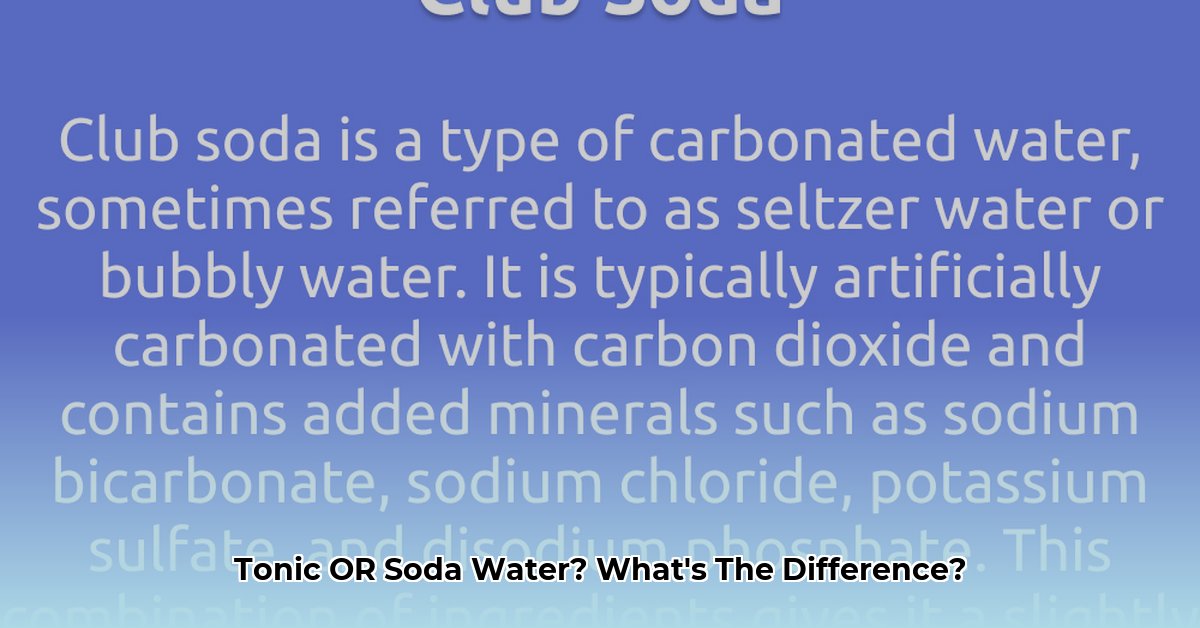The Bubbly Breakdown: Quinine and Carbonation
Tonic water and soda water might both fizz, but they’re distinctly different beverages. The key difference? Quinine. This slightly bitter compound gives tonic water its unique flavor profile, something you won’t find in plain soda water.
Tonic vs. Soda: A Quick Comparison
| Feature | Tonic Water | Soda Water |
|---|---|---|
| Key Ingredient | Quinine | Carbonated Water |
| Taste | Bitter, often sweetened (sometimes flavored) | Crisp, clean, sometimes subtly salty |
| Origins | Malaria preventative | Natural springs (or manufactured carbonation) |
| Uses | Primarily in cocktails (e.g., Gin & Tonic) | Mixers, standalone beverage |
| Sugar Content | Often contains added sugar, but options vary | Usually sugar-free |
Tonic Water: A Bittersweet History
Tonic water’s story begins with the cinchona tree native to South America. Its bark contains quinine, a compound discovered to be effective against malaria. Early European explorers and colonists used cinchona bark to ward off the disease, mixing it with water. However, the intensely bitter taste was unpalatable. To improve the flavor, sugar and other ingredients were added, eventually leading to the tonic water we know today.
Modern tonic water contains a much lower concentration of quinine than those early versions, and added sugar or high-fructose corn syrup balances the bitterness. This creates a unique flavor profile, a delicate balance of bitter and sweet. Today, you can find many variations, including flavored tonic waters (elderflower, citrus), low-sugar, and sugar-free options.
Soda Water: The Essence of Fizz
Soda water, conversely, is refreshingly simple. It’s water infused with carbon dioxide gas, creating its characteristic fizz. Some brands add mineral salts for a subtler “zing,” but the ingredient list remains short and sweet. This clean, crisp profile makes soda water wonderfully versatile. Enjoy it on its own or as a base for countless cocktails and mocktails.
Quinine: Beyond the Bite
While the quinine in tonic water is unlikely to offer significant medicinal benefits at current concentrations, some research suggests potential health benefits in moderation. It’s important to note that some individuals are sensitive to quinine and may experience mild side effects like headaches or upset stomachs with excessive consumption. As with any food or beverage, moderation is recommended, especially during pregnancy, as higher doses of quinine may carry risks.
Expanding Your Bubbly Repertoire
Beyond tonic and soda water lies a world of sparkling beverages. Club soda, often confused with soda water, includes added minerals and sometimes sodium. Seltzer is typically just carbonated water. And then there’s the burgeoning market of artisanal tonic waters, featuring unique botanicals and flavor profiles for sophisticated cocktails.
Mixing It Up: Tonic vs. Soda in Cocktails
Can you substitute soda water for tonic water in a Gin & Tonic? Yes, but expect a different drink. The absence of quinine creates a lighter, potentially less complex, cocktail. Some might find it bland; others might appreciate its simplicity. Experimentation is key – you might discover a new favorite. Don’t be afraid to explore other mixers like fresh fruit juices, herbs, syrups, and bitters.
Diving Deeper into Carbonation: The Fizzy Family
The distinction between tonic water and soda water often gets blurred, especially when considering related carbonated beverages like club soda, seltzer, and sparkling mineral water. Each has its own unique characteristics and origins, adding to the diversity of carbonated drinks.
Tonic Water: As discussed earlier, quinine is the defining characteristic of tonic water. While originally used as a malaria preventative, the quinine content in modern tonic water is much lower and unlikely to offer any significant medicinal benefits. The characteristic bitterness of quinine is often balanced with added sugars or artificial sweeteners.
Soda Water/Club Soda: These terms are often used interchangeably and generally refer to carbonated water with added minerals, such as potassium sulfate, potassium bicarbonate, or sodium bicarbonate. These minerals can contribute a subtle salty or mineral flavor to the beverage. Historically, soda water’s origins trace back to the late 18th century, when Joseph Priestley first infused water with carbon dioxide. The addition of minerals to create “club soda” came later, and the exact distinction between the two isn’t always clear-cut.
Seltzer Water: Simply put, seltzer is water that has been carbonated. Unlike club soda, it typically doesn’t contain added minerals, resulting in a neutral, clean taste.
Sparkling Mineral Water: Unlike the manufactured carbonation of other bubbly beverages, sparkling mineral water gets its fizz from naturally occurring carbon dioxide. It often contains minerals absorbed from its underground source, adding to its flavor profile. The composition of these minerals can vary significantly depending on the source, contributing to the distinct tastes of different brands.
The subtle differences between these carbonated beverages can significantly impact the flavor profile of cocktails and mixed drinks. While ongoing research continues to explore the sensory nuances of carbonation and its interaction with other ingredients, current knowledge suggests that mineral content, level of carbonation, and other factors can subtly influence the overall taste experience.
While we have a good understanding of the basic chemical compositions and historical origins of these bubbly drinks, future research could reveal more about how they interact with our senses and contribute to the enjoyment of a beverage.
- Plastic Bento Boxes Make Meal Prep and Cleanup Effortless - December 8, 2025
- Shop Bento Lunch Boxes on Sale Nearby Now - December 7, 2025
- Shop Bento Box for Sale To Find Your Ideal Lunch Container - December 6, 2025










